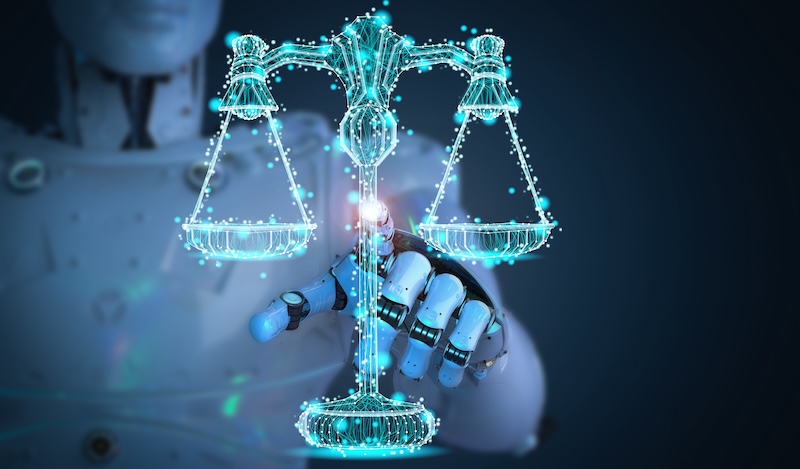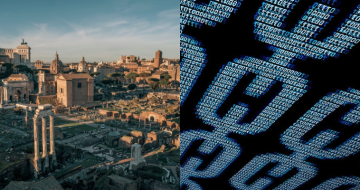BPP SQE student Eve Sprigings examines whether AI in the courtroom will enhance or erode justice

Artificial Intelligence isn’t just changing how we live and work — it’s quietly transforming the very foundations of justice in the UK. From courtrooms to corporate boardrooms, AI tools are reshaping how judges decide cases, how precedents evolve and how law firms operate. But as AI gains influence, it challenges age-old legal traditions, raising urgent questions about fairness, transparency and the very future of human judgment. Welcome to the new frontier where bytes meet briefs, and algorithms might just rewrite the law.
AI in the judiciary: A double-edged sword for legal precedents
AI’s potential to reshape binding precedents is no longer theoretical. The rise of predictive legal technologies is a prime example. Consider Garfield Law — the first AI-powered law firm recognised in England and Wales — using AI-led litigation to handle routine matters such as unpaid debt in small claims courts. Whilst this could make legal processes cheaper and faster, it arguably raises questions about maintaining quality and public trust where human judgment has historically been paramount.
Other AI tools like ROSS Intelligence and Legal Robot that help lawyers analyse judicial reasoning patterns even challenge the ethics behind today’s case law accessibility. For example, the antitrust claim “ENOUGH” on ROSS challenging legal paywalls imposed by large sites Westlaw and Thomson Reuters, pushing for broader access to public caselaw. Though not yet part of judicial decision-making, these AI systems hint at a future where algorithms influence precedent and legal interpretation—challenging outdated, gated legal services.
Since the internet’s rise, digitisation means the birth of AI is only taking this further. AI systems can process vast legal databases, potentially highlighting new interpretations or trends that allow for legal doctrine evolution.
A University of Cambridge study highlights AI’s ability to detect judicial decision patterns through case trend analysis, suggesting future shifts in legal standards. But it’s not flawless: AI can both augment and undermine the rule of law, reminding us that error and bias remain concerns.
The human element in AI-assisted justice
Human oversight remains critical. The Alan Turing Institute of Northumbria University scrutinises AI-assisted sentencing tools for errors or procedural irregularities. These considerations underscore the need for transparency, accountability, and human reasoning at the heart of justice—even as automated decision-making grows.
Tools like Harm Assessment Risk Tool (HART), used since 2017 to predict reoffending risks in England and Wales, are already influencing custodial decisions and police work. Such data-driven algorithms may reshape sentencing precedents, but concerns about socio-demographic bias — such as postcode-based discrimination — highlight challenges in balancing data insights with fairness.
AI and technology law: Intellectual property and beyond
AI’s impact on technology law, especially intellectual property (IP), raises thorny questions. Professor Ryan Abbott’s “The Reasonable Robot” explores whether AI-generated inventions deserve patent protection. The European Patent Office’s 2023 ruling on AI inventorship highlights ongoing legal uncertainty around AI’s ownership rights, signalling IP law’s rapid evolution.
UK parliamentary debates this year reflect broader concerns — AI is poised to reshape corporate governance, case management, and dispute resolution. Internationally, AI’s geopolitical importance grows: for instance, US-Saudi talks over Nvidia’s AI chips reveal AI as a new diplomatic currency, overtaking oil as the trade driver.
Want to write for the Legal Cheek Journal?
Find out moreChina’s “Smart Courts,” launched by the Supreme People’s Court in 2016 offer a glimpse of AI-driven judicial innovation. Originally focused on traffic cases, these courts enabled smooth transitions to online procedures during COVID-19, balancing technological efficiency with legal norms. They demonstrate that AI’s role in justice isn’t about replacing human judgment but streamlining administration and maintaining court deadlines.
One notable case illustrating AI’s complexity in IP is Li v Liu [2023] from Beijing Internet Court. It involved an AI-generated image created with Stable Diffusion, and the Court considered copyright infringement claims amid AI’s growing role in artistic creation. Here, decisions remain highly case-specific, reflecting how nascent AI law still is.
AI beyond tech: Transforming wider legal practice
AI’s reach extends well beyond tech law. Automated contract drafting and predictive analytics now assist employment law firms in anticipating disputes, while recruitment agencies deploy AI tools to screen candidates—though risks of biased outcomes remain a worry.
Data privacy law, particularly under the UK’s General Data Protection Regulation 2021 (GDPR), exemplifies AI’s regulatory challenges. Companies increasingly use AI to ensure compliance, pushing legal governance toward greater rigor and transparency. AI isn’t just shaping law; it’s reshaping how firms manage legal risk internally.
AI in court operations: Building a new legal infrastructure
UK courts are rapidly digitising, with AI-driven tools streamlining everything from e-filing and case scheduling to virtual hearings. The HM Courts & Tribunals Service (HMCTS) employs AI to enhance operational efficiency, helping courts focus more on substantive justice rather than administrative logistics.
Online dispute resolution (ODR) systems powered by AI are also gaining ground, especially for small claims—reducing backlog and improving access. Yet critics warn that sensitive cases, such as family law disputes, demand nuanced human judgment that AI cannot replace.
Returning to China’s experience, their Smart Courts reveal that balanced AI use—strictly monitored and focused on organizational efficiency—can reduce backlog and enhance judicial fairness without undermining human decision-making. Systems like Shanghai’s “206 system” use AI for evidence analysis and sentencing support, illustrating how technology can create a more cost-effective, straightforward judiciary.
Conclusion: The future of law in an AI-driven world
AI is no futuristic fantasy—it’s here, reshaping the UK’s judiciary and legal culture with unprecedented speed. As AI influences criminal justice and beyond, ethical concerns about bias and judicial independence demand ongoing scrutiny.
The British Computer Society (BCS) notes AI’s potential to support health and social care decisions, mirroring AI’s intended role in law: to assist—not replace—human roles. Garfield Law’s pioneering AI-driven model exemplifies this future, easing public sector burdens whilst maintaining core legal values.
Whether AI becomes a subtle tool enhancing judicial reasoning or a key player in shaping legal norms, the next decade will see it fundamentally alter UK law. This shift offers fresh opportunities for emerging legal sectors but also challenges traditional case law and statutes that underpin our legal culture—wiping away centuries of tradition almost as swiftly as a digital swipe.
Worldwide, governments are in a high-tech arms race to regulate AI-related IP, compliance, and broader legal issues, seeking a delicate balance between protecting national priorities and fostering technological innovation.
The challenge? Ensuring that AI strengthens justice rather than dilutes it — guarding the human heart of law even as machines take their place in the courtroom.
Eve Sprigings is a law graduate currently undertaking the SQE Diploma at BPP University. She has garnered experience across chambers, commercial law firms, and international legal settings, with a focus on legal research, contract analysis, and in both contentious and non-contentious matters. Eve has a strong interest in commercial and corporate Law, as well as data protection, and is passionate about making modern legal frameworks accessible and understandable to all.
The Legal Cheek Journal is sponsored by LPC Law.

 (
( (
(

